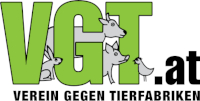VGT on the EU Commission’s proposal for stricter animal transport regulations.
It is truly shameful that the EU Commission continues to postpone real improvements in animal welfare through sham measures. This despite knowing that animal protection is an important concern for more than 80 percent of EU citizens, as both Vice President Maroš Šefčovič and EU Commissioner Stella Kyriakides said in a statement when presenting the proposals.
Isabell Eckl
Vienna (OTS) – For years, a large majority of the EU population has been calling for improvements to the intolerable conditions under which 1.6 billion animals have to suffer every year when transported within Europe and from Europe to third countries.
Now the EU Commission has finally presented a long-awaited proposal to tighten the 20-year-old EU Animal Transport Regulation (EU-TTVO). What should be highlighted positively is that the maximum transport times are to be reduced and the minimum age of calves and other unweaned animals for transport is to be increased from two to five weeks. However, the fact that exports of live animals to third countries should continue to be permitted is incomprehensible and a mockery of the legitimate animal protection interests of European citizens.
The Commission’s proposal does provide for tightening the rules for the export of live animals from the Union, “including better controls in third countries so that they comply with the standards applicable in the EU”. However, this only applies to transport there. The painful fate that awaits many animals after their transport there continues. Numerous revelations by European animal protection organizations, including the ASSOCIATION AGAINST ANIMAL FACTORIES, have demonstrated for years the cruel tortures these individuals are subjected to when there are no animal protection laws that could protect them from it. Pictures from Animals International show how conscious young cattle have their eyes gouged out or their foot tendons cut in order to immobilize them. In addition, bleeding without anesthesia is a common method in many non-European countries.
With regard to calf transport, it should be noted that the Commission’s proposal to increase the minimum age for transport of calves to five weeks is only a statutory provision of the law currently in force. If the currently valid version of the EU TTVO were to be interpreted correctly, the transport of calves under five weeks of age has long been prohibited. Between three and five weeks they are in an immunological gap that makes them unfit for transport and therefore prohibits their transport. Nevertheless, countless transporters with younger calves roll along Europe’s roads every day. In addition, animals that have not been weaned should not be transported for longer than eight hours in the future. However, they may be transported for longer periods if there is a suitable feeding system for milk or milk replacer on board. However, since this is not technically feasible and it cannot be guaranteed that every single young animal will actually consume enough food while traveling on the truck, this innovation is ineffective. Even eight hours of transport is still too long for baby animals that are just a few weeks old. It is good that collection point hopping should be prevented by a new definition of shipping and destination. Accordingly, the animals must have remained in a specific place for at least one week before or after transport in order for this to be considered the place of dispatch or destination.
The maximum transport time for adult slaughter animals should be reduced from 29 hours to 21 hours. They must then be granted a rest period of 24 hours, after which they may be transported for another 21 hours. Although this regulation is an improvement, it is only a minor one, which still causes immense, avoidable animal suffering. The ASSOCIATION AGAINST ANIMAL FACTORIES requires a maximum of eight hours of transport time for adult animals.
It is also disappointing that the transport of animals by ship will continue to be permitted without a time limit. The specious argument that the animals are less stressed on the ship than on the road does not justify continuing to subject them to the hardships associated with ship transport indefinitely. Just last summer, the ASSOCIATION AGAINST ANIMAL FACTORIES discovered at the port of Cartagena in Spain how brutally cattle from all over Europe were treated when they were loaded onto ships. And the conditions for the animals on board are often more than questionable. The extent of animal suffering usually only becomes apparent when something happens, as was the case with the two ships Karim Allah and ElBeik, which wandered across the Mediterranean for about three months loaded with thousands of cattle as they reached their destinations in Turkey and Libya were not allowed to dock due to bluetongue disease.
Isabell Eckl, VGT animal transport campaigner: “It is truly shameful that the EU Commission continues to postpone real improvements in animal welfare through sham measures. “This is despite the knowledge that animal welfare is an important concern for more than 80 percent of EU citizens, as both Vice President Maroš Šefčovič and EU Commissioner Stella Kyriakides said in a statement when presenting the proposals.”
The ASSOCIATION AGAINST ANIMAL FACTORIES continues to call for a ban on exports to third countries as well as on the transport of unweaned animals and calls on the responsible ministers Rauch and Totschnig to put pressure on the EU level for effective improvements in animal protection instead of being satisfied with pseudo-measures.
Animal transport petition
Help avoid animal transport or at least make it more bearable!
Questions & Contact:
VGT – ASSOCIATION AGAINST ANIMAL FACTORIES
Isabell Eckl
0677 637 244 50
Isabell.eckl@vgt.at
https://vgt.at
